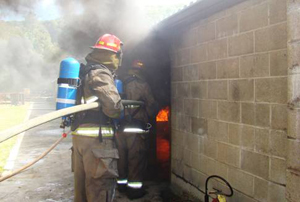NIOSH Mining Safety and Health Research
Emergency Response and Rescue Program |
| See also: Emergency response and rescue publications, Emergency response and rescue highlights |
 The Mine Emergency Escape & Response (MEER) Program enhances the safety and effectiveness of mine rescue and fire brigade teams and evacuating miners by implementing realistic training simulations and improving the procedures and technology used for mine rescue, exploration, recovery, firefighting, and escape & evacuation operations. MEER does research into issues in escape and rescue from mine emergencies, including organizational and individual response, traumatic incident stress, worker expectations and incident command center coordination.
The Mine Emergency Escape & Response (MEER) Program enhances the safety and effectiveness of mine rescue and fire brigade teams and evacuating miners by implementing realistic training simulations and improving the procedures and technology used for mine rescue, exploration, recovery, firefighting, and escape & evacuation operations. MEER does research into issues in escape and rescue from mine emergencies, including organizational and individual response, traumatic incident stress, worker expectations and incident command center coordination.
Over the last decade, we've cooperated in these areas with the Mine Safety and Health Administration, state mining agencies, mine companies, and labor organizations. For example, NIOSH conducted 84 realistic mine rescue and fire brigade team training exercises at the Lake Lynn Laboratory and Bruceton Safety Research Coal Mine in which 346 teams have participated, some multiple times. NIOSH has also trained 1875 miners in their own mines to evacuate through smoke-filled entries. These exercises are designed to test training aids and procedures in as real conditions as possible and help prepare responders for actual emergency situations.
During these exercises, NIOSH researchers have identified, developed, and evaluated improved technology for emergency responders, such as green hand-held lasers and high intensity LED strobe lights. Both of these devices gained industry acceptance partially through NIOSH research and the manufacturers have obtained MSHA permissibility approval. Researchers also developed and/or evaluated a lighted rescue team linkline (patented), an inflatable partition for high-expansion foam generators to fight fires (patented), thermal imaging cameras, wireless warning and communication systems, lifeline pulleys, as well as colored chemical lightsticks and directional lifelines now required in all escapeways.
Mine rescue simulations and in-mine smoke training exercises are being developed, conducted, and evaluated in cooperation with State agencies and mining companies at Lake Lynn Experimental Mine, Bruceton Safety Research Mine and at operating mines. During the underground exercises, rescue teams explore and map smoke-filled passageways, search for missing miners, administer first aid to injured miners, support bad roof by erecting standing support, and reestablish ventilation. Team members also fight gas or liquid fuel fires and conveyor belt fires on the surface with dry chemical powder, high-expansion foam, and water. Improved technologies such as lighted vests, thermal imaging cameras, communications systems, strobe lights, and lifelines are also evaluated during these exercises.
For additional information on Mine Emergency Escape & Response contact:
Dan Alexander
Pittsburgh Research Lab
412-386-4468
DAlexander3@cdc.gov